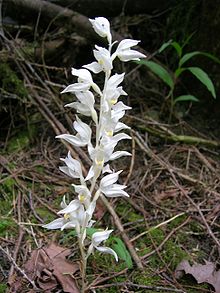Cephalanthera austiniae
| Phantom orchid | |
|---|---|

| |
| Scientific classification | |
| Kingdom: | |
| (unranked): | |
| (unranked): | |
| Order: | |
| Family: | |
| Subfamily: | |
| Tribe: | Neottieae
|
| Subtribe: | Limodorinae
|
| Genus: | |
| Species: | C. austiniae
|
| Binomial name | |
| Cephalanthera austiniae | |
| Synonyms[1] | |
| |
Cephalanthera austiniae is a species of orchid known by the common names phantom orchid and snow orchid because the entire plant is white except for a few yellow markings on the flowers.
The orchid is native to the western United States (California, Oregon, Washington and Idaho), and to British Columbia, Canada. Cephalanthera austiniae is the only species of genus Cephalanthera native to the Western Hemisphere.[1][2][3]
This is also the only Cephalanthera species entirely dependent on symbiotic mycorrhizae for its nutrition. This mycoheterotrophic orchid has no chlorophyll, so it makes no energy for itself.
Description
Cephalanthera austiniae is a distinctive plant, rising from the dark, moist forest floor on waxy white stems and bearing orchid blossoms which are white or yellowish with yellow centers. Its leaves, if present, are rudimentary since such structures are not needed for collecting sunlight.[2]
Conservation
The plant is becoming more scarce as its habitat, dense, isolated forest, becomes more rare.
References
External links
 Data related to Cephalanthera austiniae at Wikispecies
Data related to Cephalanthera austiniae at Wikispecies- Calflora Database: Cephalanthera austiniae (Phantom orchid)
- USDA Plants Profile:
- Info Sheet - Canadian Phantom Orchids
- Photo gallery
- Cephalanthera
- Epidendroideae species
- Myco-heterotrophic orchids
- Orchids of Canada
- Orchids of the United States
- Orchids of California
- Flora of the West Coast of the United States
- Flora of British Columbia
- Flora of Idaho
- Flora of Nevada
- Flora of Oregon
- Flora of Washington (state)
- Flora of the Cascade Range
- Flora of the Klamath Mountains
- Flora of California
- Flora of the Sierra Nevada (U.S.)
- Natural history of the California Coast Ranges
- Natural history of the Peninsular Ranges
- Plants described in 1877
- Epidendroideae stubs
